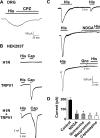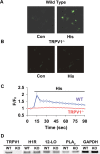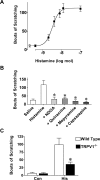TRPV1 mediates histamine-induced itching via the activation of phospholipase A2 and 12-lipoxygenase
- PMID: 17329430
- PMCID: PMC6673467
- DOI: 10.1523/JNEUROSCI.4643-06.2007
TRPV1 mediates histamine-induced itching via the activation of phospholipase A2 and 12-lipoxygenase
Abstract
Histamine provokes itching and is a major skin disease complaint. Histamine is known to excite a subset of sensory neurons, predominantly C-fibers. Although histamine is pruritogenic, its signaling pathways that excite sensory neurons have not been identified. Because the metabolic products of lipoxygenases (LOs) activate transient receptor potential vanilloid receptor-1 (TRPV1) in sensory neurons, we hypothesized that histamine excites sensory neurons by activating TRPV1 via phospholipase A2 (PLA2) and LO stimulation. In cultured sensory neurons, histamine evoked inward currents that were reduced by capsazepine, a TRPV1 blocker. Moreover, histamine provoked inward currents when histamine receptor subtype 1 (H1R) and TRPV1 were expressed heterologously, but not when H1R or TRPV1 was expressed alone. In addition, histamine caused Ca2+ influxes in sensory neurons in wild-type mice but not in TRPV1-/- mice. Furthermore, histamine caused a 2.5-fold increase in the production of 12-hydroxyeicosatetraenoic acid, a metabolite of LO, in cultured sensory neurons. When injected subcutaneously into the necks of mice, histamine caused bouts of scratching, which were greatly reduced by pretreatment with capsazepine, a TRPV1 blocker, and by inhibitors of PLA2, LO, and H1R. Furthermore, mice lacking TRPV1 markedly reduced histamine-induced scratching compared with wild type. Together, these results indicate that TRPV1 plays a key role in mediating the pruritogenic action of histamine via the PLA2/LO pathway.
Figures




Similar articles
-
Histamine-induced Ca(2+) influx via the PLA(2)/lipoxygenase/TRPV1 pathway in rat sensory neurons.Neurosci Lett. 2004 May 6;361(1-3):159-62. doi: 10.1016/j.neulet.2004.01.019. Neurosci Lett. 2004. PMID: 15135918
-
Histamine potentiates acid-induced responses mediating transient receptor potential V1 in mouse primary sensory neurons.Neuroscience. 2010 Mar 10;166(1):292-304. doi: 10.1016/j.neuroscience.2009.12.001. Epub 2009 Dec 16. Neuroscience. 2010. PMID: 20006972
-
TRPV1 and TRPA1 Channels Are Both Involved Downstream of Histamine-Induced Itch.Biomolecules. 2021 Aug 6;11(8):1166. doi: 10.3390/biom11081166. Biomolecules. 2021. PMID: 34439832 Free PMC article.
-
Melittin activates TRPV1 receptors in primary nociceptive sensory neurons via the phospholipase A2 cascade pathways.Biochem Biophys Res Commun. 2011 Apr 29;408(1):32-7. doi: 10.1016/j.bbrc.2011.03.110. Epub 2011 Mar 29. Biochem Biophys Res Commun. 2011. PMID: 21453681 Free PMC article.
-
Activation and activators of TRPV1 and their pharmaceutical implication.Curr Pharm Des. 2005;11(21):2687-98. doi: 10.2174/1381612054546789. Curr Pharm Des. 2005. PMID: 16101449 Review.
Cited by
-
Inhibition of M/Kv7 Currents Contributes to Chloroquine-Induced Itch in Mice.Front Mol Neurosci. 2020 Jun 30;13:105. doi: 10.3389/fnmol.2020.00105. eCollection 2020. Front Mol Neurosci. 2020. PMID: 32694980 Free PMC article.
-
Development and validation of an automated system for detection and assessment of scratching in the rodent.J Neurosci Methods. 2012 Oct 15;211(1):1-10. doi: 10.1016/j.jneumeth.2012.08.002. Epub 2012 Aug 13. J Neurosci Methods. 2012. PMID: 22971351 Free PMC article.
-
Mast cell-sensory neuron crosstalk in allergic diseases.J Allergy Clin Immunol. 2024 Apr;153(4):939-953. doi: 10.1016/j.jaci.2024.02.005. Epub 2024 Feb 17. J Allergy Clin Immunol. 2024. PMID: 38373476 Review.
-
Therapy of pruritus.Expert Opin Pharmacother. 2010 Jul;11(10):1673-82. doi: 10.1517/14656566.2010.484420. Expert Opin Pharmacother. 2010. PMID: 20426711 Free PMC article. Review.
-
Facial injections of pruritogens and algogens excite partly overlapping populations of primary and second-order trigeminal neurons in mice.J Neurophysiol. 2010 Nov;104(5):2442-50. doi: 10.1152/jn.00563.2010. Epub 2010 Aug 25. J Neurophysiol. 2010. PMID: 20739601 Free PMC article.
References
-
- Andoh T, Kuraishi Y. Intradermal leukotriene B4, but not prostaglandin E2, induces itch-associated responses in mice. Eur J Pharmacol. 1998;353:93–96. - PubMed
-
- Andrew D, Craig AD. Spinothalamic lamina I neurons selectively sensitive to histamine: a central neural pathway for itch. Nat Neurosci. 2001;4:72–77. - PubMed
-
- Benditt EP, Bader S, Lam KB. Studies of the mechanism of acute vascular reactions to injury. I. The relationship of mast cells and histamine to the production of edema by ovomucoid in rats. AMA Arch Pathol. 1955;60:104–115. - PubMed
-
- Bickford RG. Experiments relating to the itch sensation, its peripheral mechanism, and central pathways. Clin Sci. 1937;3:377–386.
Publication types
MeSH terms
Substances
LinkOut - more resources
Full Text Sources
Other Literature Sources
Molecular Biology Databases
Miscellaneous
